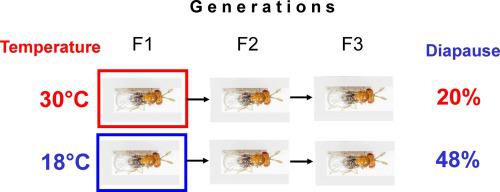Journal of Insect Physiology ( IF 2.3 ) Pub Date : 2020-06-01 , DOI: 10.1016/j.jinsphys.2020.104072 Sergey Ya Reznik 1 , Natalia D Voinovich 1 , Konstantin G Samartsev 1

|
Adaptive grandmaternal thermal effect, wherein the grandmaternal thermal environment affects the induction of progeny diapause two generations later, has not been studied in any insect system. We have studied this effect in the parthenogenetic egg parasitoid Trichogramma telengai Sor. (Hymenoptera: Trichogrammatidae) under laboratory conditions. The grandmaternal generation developed at temperatures from 18 to 30 °C combined with short (L:D = 12:12) or long (L:D = 18:6) photoperiod. The maternal generation developed at the same two photoperiods combined with low (20 °C) or high (30 °C) temperature. The progeny generation developed at 14 °C and L:D = 12:12. The grandmaternal temperature response was consistent with an adaptive response (low temperature induces facultative prepupal winter diapause two generations later) and rather strong (ranged up to 20–25%). The experiments suggested that both grandmaternal and maternal thermal effects are based on the influence of temperature on photoperiodic induction of diapause. However, experiments also revealed substantial differences between the grandmaternal and maternal thermal responses. In particular, the grandmaternal thermal response was observed only at short-day grandmaternal photoperiod, whereas the maternal thermal response was independent both of maternal and grandmaternal photoperiods. Although under natural conditions the adaptive value of the grandmaternal thermal response in T. telengai is most probably low, this effect should be considered in physiological models of diapause induction and can be important for mass rearing of Trichogramma species.
中文翻译:

祖母温度对电赤眼赤眼蜂(膜翅目:Trichogrammatidae)滞育诱导的影响。
尚未在任何昆虫系统中研究过适应性祖母热效应,其中祖母热环境会在两代后影响子代滞育的诱导。我们已经在孤雌生殖卵寄生性拟南芥Trichogramma telengai中研究了这种效应对不起 (膜翅目:Trichogrammatidae)在实验室条件下。祖母一代在18至30°C的温度下与短(L:D = 12:12)或长(L:D = 18:6)光周期结合形成。母体一代在相同的两个光周期和低温(20°C)或高温(30°C)的共同作用下发育。后代在14°C和L:D = 12:12时发育。祖母的温度反应与适应性反应一致(低温导致两代后发生兼性的pu前冬季滞育),并且强度较强(范围高达20%至25%)。实验表明,祖母和母体的热效应均基于温度对滞育的光周期诱导的影响。然而,实验还揭示了祖母和母体热反应之间的实质差异。特别地,仅在短日祖母光周期中观察到祖母热响应,而母体热响应独立于母婴和祖母光周期。尽管在自然条件下,祖母热响应的适应性价值Telengai可能很低,在滞育诱导的生理模型中应考虑这种作用,这对于赤眼蜂物种的大规模饲养可能很重要。











































 京公网安备 11010802027423号
京公网安备 11010802027423号